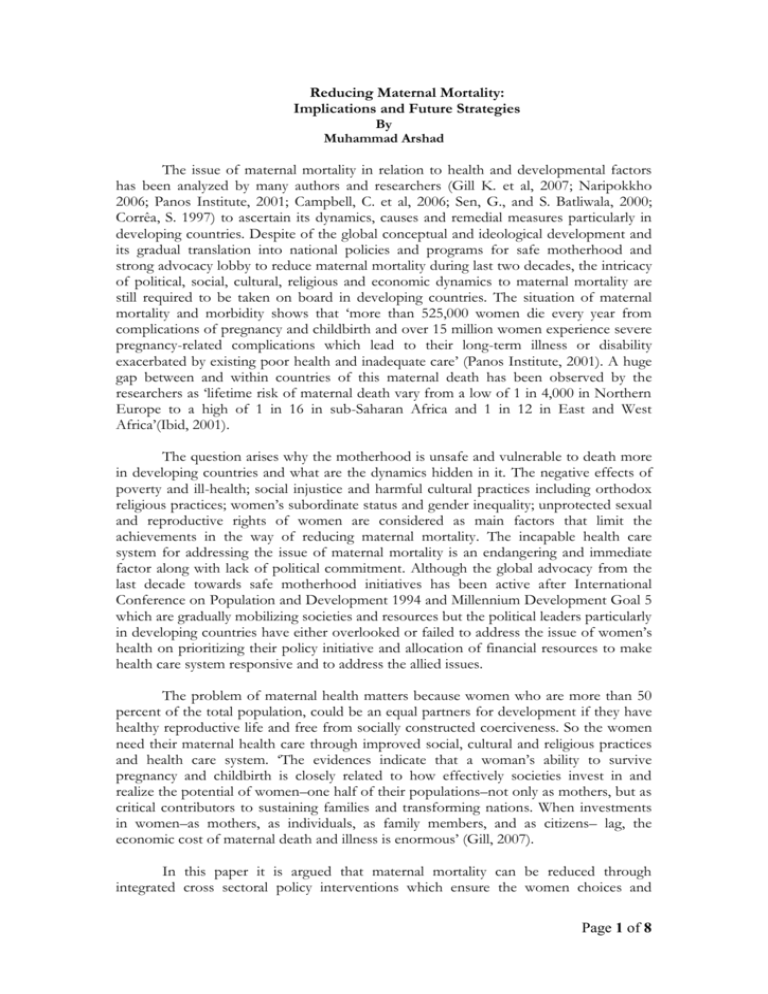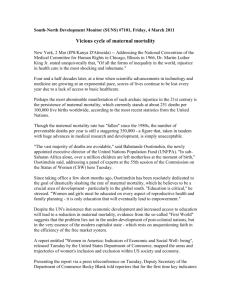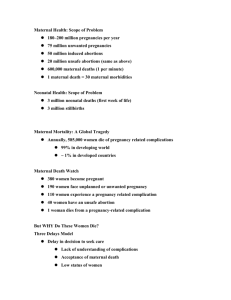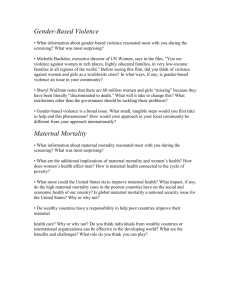
Reducing Maternal Mortality:
Implications and Future Strategies
By
Muhammad Arshad
The issue of maternal mortality in relation to health and developmental factors
has been analyzed by many authors and researchers (Gill K. et al, 2007; Naripokkho
2006; Panos Institute, 2001; Campbell, C. et al, 2006; Sen, G., and S. Batliwala, 2000;
Corrêa, S. 1997) to ascertain its dynamics, causes and remedial measures particularly in
developing countries. Despite of the global conceptual and ideological development and
its gradual translation into national policies and programs for safe motherhood and
strong advocacy lobby to reduce maternal mortality during last two decades, the intricacy
of political, social, cultural, religious and economic dynamics to maternal mortality are
still required to be taken on board in developing countries. The situation of maternal
mortality and morbidity shows that ‘more than 525,000 women die every year from
complications of pregnancy and childbirth and over 15 million women experience severe
pregnancy-related complications which lead to their long-term illness or disability
exacerbated by existing poor health and inadequate care’ (Panos Institute, 2001). A huge
gap between and within countries of this maternal death has been observed by the
researchers as ‘lifetime risk of maternal death vary from a low of 1 in 4,000 in Northern
Europe to a high of 1 in 16 in sub-Saharan Africa and 1 in 12 in East and West
Africa’(Ibid, 2001).
The question arises why the motherhood is unsafe and vulnerable to death more
in developing countries and what are the dynamics hidden in it. The negative effects of
poverty and ill-health; social injustice and harmful cultural practices including orthodox
religious practices; women’s subordinate status and gender inequality; unprotected sexual
and reproductive rights of women are considered as main factors that limit the
achievements in the way of reducing maternal mortality. The incapable health care
system for addressing the issue of maternal mortality is an endangering and immediate
factor along with lack of political commitment. Although the global advocacy from the
last decade towards safe motherhood initiatives has been active after International
Conference on Population and Development 1994 and Millennium Development Goal 5
which are gradually mobilizing societies and resources but the political leaders particularly
in developing countries have either overlooked or failed to address the issue of women’s
health on prioritizing their policy initiative and allocation of financial resources to make
health care system responsive and to address the allied issues.
The problem of maternal health matters because women who are more than 50
percent of the total population, could be an equal partners for development if they have
healthy reproductive life and free from socially constructed coerciveness. So the women
need their maternal health care through improved social, cultural and religious practices
and health care system. ‘The evidences indicate that a woman’s ability to survive
pregnancy and childbirth is closely related to how effectively societies invest in and
realize the potential of women–one half of their populations–not only as mothers, but as
critical contributors to sustaining families and transforming nations. When investments
in women–as mothers, as individuals, as family members, and as citizens– lag, the
economic cost of maternal death and illness is enormous’ (Gill, 2007).
In this paper it is argued that maternal mortality can be reduced through
integrated cross sectoral policy interventions which ensure the women choices and
Page 1 of 8
decisions regarding when, how and how often she gives child birth. The challenges in the
way of integration may include protection of women reproductive and sexual rights on
priority basis through providing efficient maternity health care system; minimizing
gender inequality and women subordinate status to enhance their empowerment and
reduce discriminatory social, cultural, religious and economic practices that effects
maternal health. To this argument, the paper aims to analyze how the issue of maternal
mortality in relation to improved maternal health and care required integrated health and
development policies and what are the future challenges that have to be faced by the
countries in reducing maternal mortality as per agreed international instruments including
ICPD 1994 and Millennium Development Goal 5. First, the paper will determine the
socio-economic and cultural dynamics which contributes towards maternal mortality.
Second, it will consider how the women sexual and reproductive rights are protected to
improve their maternal health. Third, the responsiveness of reproductive health care
system will be examined for safe motherhood and to ensure emergency obstetric care.
Lastly, the conclusion will be discussed ensuring women wellbeing to control over their
fertility and ‘birth rights’ for integrated policy formulation and implementation for
developing countries.
1.
Maternal Health: Women Subordination and Socio-Cultural Practices
The incidences of maternal mortality are unequal and uneven between developed
and developing countries and within countries. According to Panos Institute (2001), ‘for
each woman who dies of maternal causes in the developed world, 99 will die in the
developing world. A woman in Afghanistan or Sierra Leone has a 1 in 7 risk of death
during her reproductive years; in Peru it is 1 in 85, in China 1 in 400, in Norway 1 in
7,300 and in Spain 1 in 9200’. The differences and uneven tragedy means the maternal
mortality can be reduced and prevented as per experiences of the developed nations or
where the mortality rate is comparatively low. How these nations have reduced their
maternal mortality and what measures adopted by them are questions to look into by the
developing countries. The causes of ‘social injustices such as early marriage and violence,
poverty which leads to malnourishment and anaemia, undesired fertility and lack of
access to safe, legal abortion and adequate maternity services’ have been identified by the
Panos Institute (2001). Gill et al. (2007) in their review paper have also mentioned that
“the regions with the poorest maternal health 30 years ago—sub–Saharan Africa and
South–Central Asia—have progressed the least. Nonetheless, there are success stories
where poor maternal health has been turned around. Egypt, Honduras, Malaysia, Sri
Lanka, Thailand, and parts of Bangladesh all halved their maternal mortality ratios over
the last several decades” and suggested that MDG 5, which targets 75% reduction in
maternal mortality, is achievable, provided there is political will and financial investment
(Gill et al. 2007 quoted Ronsmans and Graham 2006; Abouzahr and Wardlaw 2001; UN
Millennium Project 2005b; reedman, Waldman et al. 2005).
The maternal health of women cannot be seen only in health perspective but it
interacts around all aspects of women life as member of family, mother and part of
community/society. The discriminatory social and cultural practices against women in
families and society obstruct in making decisions regarding their maternal and
reproductive life matters. Sen et al. (2000) while analysing women empowerment and
their maternal health found that ‘the subordination of women has been achieved
exploitation and control of their sexual and reproductive lives with often disastrous
consequences to their health and status like women accepts unwanted and coercive
sexual relations, unwanted pregnancies and child bearing; physical, sexual and
Page 2 of 8
psychological abuse and violence in home and family including marital rape, battering,
incarceration, and incest; become infected by sexual transmitted diseases and HIV/AIDS
due to lack of control over sexual relations; blaming and victimizing for reproductive
outcome like bearing daughters instead of sons or being infertile. Gill et al. (2007)
concluded that ‘poor maternal health is of serious concern because women’s health as
mothers is intricately linked with other aspects of women’s lives including i) the
continuing poverty and overall poor health status of women in much of the developing
world contribute to continuing poor maternal health; ii) where women have low status
and are disempowered, maternal health is likely to be poor; iii) conversely, where women
have power in the household, and access to resources such as education and economic
opportunity, they are better able to access and use services during pregnancy and
childbirth or otherwise maintain good maternal health and iv) other aspects of women’s
reproductive health, especially their ability to control their fertility and avoid HIV
infection, are also closely associated with their health as mothers’.
While formulating Program of Action (Chapter IV) of International Conference
on Population and Development 1994, new issues of women empowerment and cultural
practices were identified as hindering factors toward women reproductive health and
rights. ‘Chapter IV, the main chapter on empowerment states that it is unequal power
relations which impede women’s attainment of healthy and fulfilling lives and goes on to
specify a number of actions (legal, political, economic and cultural) both preventive and
promoter, that government and others need to take in order to help women to overcome
these relations’ (Sen et al. 2000). But, at the same time the concept of women
empowerment in relation to promoting women sexual and reproductive health and rights
was not clearly unpacked to facilitate the policy and program formulators and
implementers which necessarily required addressing unequal and uneven social, cultural
and fundamental religious practices mostly in developing countries.
The maternal mortality is however preventable for which a serious attention is
needed in formulation of integrated policies and programs to reduce and prevent
maternal mortality and morbidity through addressing its direct factors (access to efficient
and adequate provision of maternity health care and legal and safe abortion facilities) and
indirect factors (poverty, social injustice, factors of three delays, women’s discriminatory
and subordinate status and early marriages). Considering the importance of social and
cultural factors in reducing maternal mortality, the WHO described it as “Maternal
mortality is an indicator of disparity and inequity between men and women and its extent
a sign of women’s place in society and their access to social, health and nutrition services
and to economic opportunities” (WHO 1999). Gill et al. (2007) quoted Grown, Gupta et
al. 2005; Murphy 2003 that ‘Poor maternal health is not just a problem of women’s
health but also a problem of persistent poverty and gender inequality’.
2.
Maternal Health and Sexual and Reproductive Rights
The importance of sexual and reproductive rights of women cannot be denied
while analysing maternal health issues. Although the reproductive rights for safe
motherhood and sexual rights for safe womanhood are separately given attention by the
world experts during ICPD 1994 and Beijing Conference 1995 but these are interlinked
with each other to improve maternal health. The reproductive and sexual rights of
women in fact protect and promote their sexual and reproductive health which are
ensured through empowering them with access to information, reproductive health care,
and access to and use of resources that are needed for their sexual and reproductive well
Page 3 of 8
being. Referring IWHC (1994a and b), Sen et al. (2000) elaborated as “Reproductive
Rights include i) the right of all couples and individuals to decide freely and responsibly
the number, spacing and timing of their children and to have the information and means
to do so; ii) the rights to attain the highest standards of sexual and reproductive health
and the right to services and information that make this possible; and iii) the right to
make the decisions concerning reproduction, free discrimination, coercion or violence.
The Sexual Rights include i) full respect for the physical integrity of a human being’s
body including freedom from violence, mutilation or sexual assault; ii) the right to
necessary information and services to attain sexual well being with full respect for
confidentiality and without discrimination on the basis of age, gender, sexual orientation,
marital status, race, class, caste, ethnicity; and iii) the right to make choices and decisions
concerning sexuality free of discrimination, coercion, or violence”.
Providing these sexual and reproductive rights to women mean to empower
women with access to information on her sexuality, reproductive body, reducing
inequalities and subordinate status for making choices freely regarding use of
contraceptives and control over their fertility. ‘The linkages to sexual rights are clear;
sexual rights are the necessary lever by which to achieve the ‘enabling environment’
required for the fulfillment of the principles of erotic justice’ (Corrêa, S. 1997). Since the
women have the right to make decisions regarding their own body’s sexual and
reproductive health, these rights are being violated because of the subordinate status of
women in families and societies. ‘Early marriages, female genital mutilation, unwanted
child births, and violence constitute violations of women’s rights to make decisions
regarding her own body’ (UNFPA, 2007). The both, reproductive and sexual rights are
linked with a constant need of women power relation within families and accessibility
and availability of all those information and health services to be provided by the
governments in their policies, programs and practices to all couples and individuals
women without any discrimination of age, sexual orientation, marital status, race, class,
caste, ethnicity.
The denial of sexual and reproductive rights of women and particularly in youth
leads towards the issue of their stigmatization in society. Campbell et al. (2006) argued
that stigmatization of sexuality of women and parents’ refusal to youth sexuality, teenage
pregnancy and symptoms of AIDS excluded them resultantly reduced the HIV
prevention, care and treatment. As argued earlier the integrated health and development
policy interventions are therefore needed to protect the sexual and reproductive rights of
women and youth. Sharenet (2004) has suggested in this regards that ‘a potential
complete sexual and reproductive health package including HIV/AIDS should entail all
education efforts and services should be working towards reducing stigma and
discrimination related to HIV status, sexual orientation and gender; and Prevention of
unwanted pregnancies, STIs/RTIs and HIV’.
The promotion and protection of these rights to women in letter and spirit by
translating into development policies and program will be a great challenge ahead for the
governments. Because, the protection of these rights need to implement all interlinked
elements of maternal health including adequate, efficient and responsive maternal health
care facilities, emergency obstetric care, safe abortions, and poor condition of women,
social injustice and women’s disempowerment that are responsible for maternal deaths
and morbidity.
Page 4 of 8
3.
Adequate, Efficient and Responsive Reproductive Health Care System
The definition of reproductive health given in the Program of Action of Cairo
Conference 1994 implies that the people have “the right of access to appropriate healthcare services that will enable women to go safely through pregnancy and childbirth and
provide couples with the best chance of having a healthy infant. It also includes sexual
health, the purpose of which is the enhancement of life and personal relations, and not
merely counseling and care related to reproduction and sexually transmitted diseases”
(WHO 2004).
Although the mix of social, cultural and economic conditions of women creates
risks during pregnancy and childbearing which cause their maternal deaths or morbidity,
but the direct endangering factors including three delays in maternal care; inadequate and
inefficient maternity care facilities; and lack of access to safe and legal abortion and
aftercare are considered the main reasons for maternal death and morbidity. While
describing the reasons of maternal mortality, Gill et al. (2007) identified that
‘haemorrhage is the major cause of death in many parts of the developing world. Other
major causes across regions include sepsis, hypertensive disorders, unsafe abortion,
anaemia and obstructed labour’. Gill quoted Khan, Wojdyla et al. (2006) that ‘in Africa,
HIV now accounts for 6.2% of maternal deaths and it is the leading cause of maternal
deaths in some hospitals in Africa and has reversed the progress made in maternal health
in countries with particularly high rates of HIV, such as Malawi and Zimbabwe. Young
mothers are more likely to develop obstructed labour and eclampsia; the risk of death in
pregnancy and delivery is for girls under the age of 15 are five times higher than for
women in their twenties’ (Gill et al. referred UNICEF 2007).
To address these endanger factors of maternal mortality related to emergency
obstetric care, there is need to realise the effects of well-known three delays model in
national policies and strategies including i) decide to seek care, ii) reach medical facilities
and iii) receive adequate treatment in general and the socio-cultural, religious economic
discriminatory practices against women’ pregnancy and child bearing in particular. These
three delays are not so simple to realize in any single policy but it needs to address its
causal factors for example mostly during first delay phase the low socio-economic status
of women and least awareness level about her reproductive health and rights along-with
women poor power relations within family become the hindering factor to decide to seek
health care on time. The first delay then leads to getting delay in transportation and
treatment. Secondly, the lack of physical facilities and infrastructure like transport, roads
and to bear its cost to reach medical facility are other hindering factors in getting
emergency treatment to avoid complication of the pregnancy. Thirdly, the inadequate
and inefficient health care facilities (poor supplies of medicine, blood, equipment,
untrained and de-motivated personnel/doctors) are the main causes to delay in getting
timely and adequate treatment to women at health facilities. Despite of the commitment
by agreeing with international safe motherhood initiatives by the developing countries,
there is still need to combat the factors responsible for three delays which required
political commitment to design integrated and cross sectoral policy and financing for
their implementation.
The main challenges in adopting policies and/or implementing the existing
policies include the change in socio-cultural practices and values through changing
people’s attitude followed by the enactment of laws to ensure women’s reproductive
health and empowerment. Naripokkho (2006) stressed on the cultural, religious, social,
Page 5 of 8
environmental and other factors involved in making delays in getting treatment to avoid
maternal death and morbidity because these factors limits the implementation capacity of
the governments. For example, the three delays model used in “Bangladesh National
Strategy for Maternal Health” (October 2001) is still facing challenges to combat the
hindering factors involved in three delays. ‘The improvement in facilities and care in
government hospitals as a result of its implementation actually benefited the middle and
upper-middle class people more especially who are aware of these facilities and the
importance of utilizing these. This policy does not affect any group of people negatively
but it fails to improve the health condition of the poor and hardcore poor and people
living in remote villages in the country who are unaware of these facilities’ (Naripokkho,
2006). ‘The Government has been unable to ensure that at least a good percentage of
women with obstetric complications, especially eclampsia get timely and proper
treatment. The met need of Emergency Obstetric Care services is still 13% only’ (Ibid,
2006).
4.
Conclusion
The provision of adequate, efficient and responsive maternal health care and
services are important but not the only sufficient solution to reduce maternal mortality
and morbidity in developing countries unless indirect contributory socio-cultural and
economic risks factors like social injustice including early marriages, pressure to bear
children, violence; poor health condition and malnutrition of women; women
subordination and poverty are addressed taking into consideration individual women’s
health at family level. ‘The religious, cultural and social attitude towards pregnancy and
reproductive health of women suggests that a profound change in attitude is needed to
make the policy successful’ (Naripokkho, 2006).
The maternal mortality can be prevented and reduced at policy level if it is a
national priority with political and financial commitment and effective integrated cross
sectoral policies ensuring relevant institutional collaboration and stake holders to
implement. For example, Sri Lanka has reduced maternal mortality by 50% during 6-12
years through adopting sustained commitment for maternal health care priorities with
financial, managerial, and political support (Gill et al. 2007 quoted source of
Pathmanathan, Liljestrand et al. (2003). Secondly, ‘Honduras being one of the poorest
countries, challenged the problem of maternal mortality and has reduced maternal
mortality by 38% over seven years through the interventions like it was made a national
priority and resources were directed towards its reduction. The availability of emergency
obstetric care services (EOC) was improved and for women experiencing complications,
referrals were improved both by traditional as well as skilled birth assistants, thus
providing a valuable link between the health system and clients (Gill et al. 2007 referred
sources: Danel (2000); Danel and Rivera (2003).
To get these results in developing countries, first of all there is need to set a
national priority then be translated into policies. Second, the review and revision of
existing development policies are needed in a multidimensional framework of policy
options, government commitment and implementation capacity to combat direct health
factors and indirect socio-economic and cultural factors responsible for the maternal
mortality and protection of sexual and reproductive health and rights of women as
elaborated in HeRWAI (2006) to formulate a new agenda for women health and
wellbeing. Third, to avoid three delays, the awareness level of pregnant women and their
families is required to be enhanced on their reproductive complications and preparedness
Page 6 of 8
to avail timely treatment at the health facilities. Apart from availability of EOC at
community level, the adequate and efficient services are needed with all available
equipment and trained personnel. ‘What Hogan et al (2010) have shown is that
programmes to reduce fertility rates, increase individual incomes, expand maternal
education, and widen access to skilled birth attendants are having a measurable effect—
saving the lives of women during pregnancy. Even greater investment in that work is
likely to deliver even greater benefits’ (Horton, 2010).
References
Corrêa, S., (1997) From Reproductive Health to Sexual Rights: Achievements and Future
Challenges, Reproductive Health Matters. Vol. 10 (Nov): 107-116
Gill, K. et al (2007) Women Deliver for Development, Lancet Vol. 370, Oct 13, 2007 pp13471357
HeRWAI (2006) Health Rights of Women Assessment instrument, Available at:
http://www.humanrightsimpact.org/themes/womens-human-rights/herwai/
reports/resources/view/6/user_hria_reports [Accessed 05/06/2011]
Horton, R. (2010) Maternal mortality: surprise, hope, and urgent action, The Lancet, Volume 375,
Issue 9726, 8 May 2010-14 May 2010, Pages 1581-1582
Naripokkho (2006) Report on Government Policies on Eclampsia in Bangladesh and the Impact on
the Right to Health pp. 1-30. Available at: http://www.humanrightsimpact.org/
fileadmin/hria_resources/Report_of_HeRWAI_Naripokkho.pdf
[Accessed 05/06/2011]
Panos Institute (2001) The Safe Motherhood Initiative (Chapter 3) and Struggling Services (Chapter
4) and Human Rights: A New Paradigm (Chapter 7) in Birth Rights: New Approaches
to Safe Motherhood. Panos Report No 43. London. Pp. 1-2, pp. 17-21, pp. 22-26
and pp. 39-41
Sen, G., and S. Batliwala, (2000) Empowering Women for Reproductive Rights (Chapter 2) in
Presser, H. B., and G. Sen (Eds.), Women's Empowerment and Demographic
Processes: Moving Beyond Cairo. Oxford: Oxford University Press. Pp. 15-35
Sharenet (2004) AIDS, Sex & Reproduction: Integrating HIV/AIDS and Sexual and
Reproductive Health into Policies, Programs and Services, Joint Document of SHARENET, WPF and STOP AIDS NOW! Amsterdam. Pp. 1-10.
UNFPA (2007) Fact sheet: No Woman Should Die, Giving Life, PSI 2010 Flyer Working
towards MDG 5, Available at http://www.unfpa.org/webdav/site
/global/shared/safemotherhood/factsheet3_eng.pdf [Accessed 24/06/2011]
World Health Organization (1999) Reduction of Maternal Mortality: A Joint
WHO/UNFPA/UNICEF/World Bank Statement. Geneva: Available at
http://www.searo.who.int/LinkFiles/Publications_Reduction_of_Maternal_
Mortality.pdf [Accessed 25/06/2011]
World Health Organization (2004) Reproductive health strategy to accelerate progress towards the
attainment of international development goals and targets
Available at: http://www.who.int/reproductivehealth/publications/general/
RHR_04_8/en/index.html [Accessed 24/06/2011]
Page 7 of 8
Reducing Maternal Mortality:
Implications and Future Strategies
Muhammad Arshad
Masters in Development Studies from ISS
Rotterdam University, Netherlands /
Deputy Chief (Incharge)
Social Welfare and Women Development Section
Planning Commission of Pakistan
Page 8 of 8









